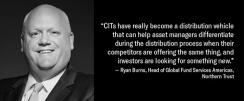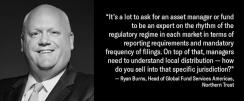Investors rely heavily on their asset management partners for sophisticated investment strategies that can weather market volatility, manage risk, and generate returns to meet expectations. From the investor viewpoint, all roads lead to returns.
Asset managers know this, of course, and it’s their primary outward looking goal. When they look inward, however, distribution is the bullseye. Having a reputation for meeting or exceeding expected returns certainly gives a distribution team leverage, but it’s also an argument many managers can make. So how can distribution teams stand out in a crowded competition?
“Like all things in the market today, distribution is highly competitive but is also becoming more challenging,” says Ryan Burns, Head of Head of Global Fund Services Americas, at Northern Trust. “Asset managers are being pressed to differentiate why an investor should purchase their fund or their strategy and what it can offer them beyond performance, and how their product fits the investor’s needs in the context of their total investment strategy. Those needs might include using the vehicles that give the investor the most comfort from an oversight perspective, for example. Just as important, managers should sharpen their focus on how and where they are growing.”
In fact, opportunities abound to create distance from the field in distribution – but it’s not especially easy for asset managers to identify the right fund wrapper, channels, and jurisdictions, any combination of which investors will clearly see as a path to achieving their growth goals.
The intersection of investment strategy and distribution
When Burns mentions that asset managers should focus on “where” they are growing he’s getting to the crux of the growth – is the target market well-defined, and has the asset manager identified the most appropriate and well-fit fund vehicles for each market?
“We’re definitely seeing people be more thoughtful regarding the focus of their distribution strategy for a particular investment, and weighing the best way to get into that distribution market,” says Burns. “The fund vehicle itself is a large part of that, and has the potential for investors to see it as an alternative to the typical wrappers for a strategy.”
In the institutional space in particular, asset managers have plenty of options they can tap into that are good for end investors and that can help grow distribution. As Burns notes, it can pay to look beyond traditional U.S. registered mutual funds. They might be an effective tool for broad distribution, but they can also be costly and burdensome to operate. Options for managers to consider (and to avoid opening separately managed accounts) include collective investment trusts (CITs), which are among the unregistered products that are used by the institutional investor market.

Retirement assets are a major focus of many institutional investors, and CITs are essentially custom built to service qualified retirement plans.
“When an investment strategy and program are more tailored and appetizing to a particular audience, we’re definitely seeing distribution grow,” says Burns. “CITs have been around for a number of years, but we’re seeing them gain wider acceptance across investment committees during the allocation decision-making process, and ultimately a CIT offers a lower cost regulatory regime compared to a mutual fund. CITs have really become a distribution vehicle that can help asset managers differentiate during the distribution process when their competitors are offering the same thing, and investors are looking for something new.”
Unregistered products as a whole – a group that beyond CITs includes private fund options – offer asset managers and investors tremendous flexibility, as well. They provide alternative legal structures, which are viable both for alternative strategies and in the traditional long-only strategy space. The ’40 Act includes provisions that exclude certain funds from the requirements to be established and operated in accordance with the full suite of fund regulations that mutual funds must follow.
Choosing the right wrapper for a strategy can help attract investors, but at the same time the bigger distribution wins incorporate excellence across what is truly a multi-disciplinary pursuit. Jurisdictional issues, for example, can present a blockade to distribution that is especially difficult to navigate solo – but if navigated well, present an opportunity for differentiation. For a manager to handle this important process internally requires deep knowledge of jurisdictional differences and how they affect investors, and also the implications for the firm itself of registering and creating investment strategies in each market.

“It’s a lot to ask for an asset manager or fund to be an expert on the rhythm of the regulatory regime in each market in terms of reporting requirements and mandatory frequency of filings,” says Burns. “On top of that, managers need to understand local distribution – how do you sell into that specific jurisdiction?”
Creating a segregation of disciplines all aimed at a single end goal – growing distribution – can create enormous benefits for an asset manager, but as Burns notes, it’s a tall order. To make it work, a multitasking partner with a global presence, such as Northern Trust, can be invaluable.
Platform matching to partner
To provide asset managers with the capabilities necessary to grow distribution, Burns and his team strive to deliver a platform experience that feels turnkey despite it being customized for each partner.
“Regardless of the wrapper in the U.S., we want to have as close to platform-like solutions available as possible, whether it’s for series trusts and mutual funds, or the CITs and the trustee role,” says Burns. “How many of the activities on the unregistered and private fund side can we take on that will allow them to continue to meet a growing regulatory regime? A platform approach that is consistent across the various wrappers hopefully will allow clients to meet their distribution channel right where they want to be – with the right fund wrapper, and without having any huge disparities from the manager’s operating model. We don’t want them to have to adapt just because it’s a CIT versus a mutual fund.”
The ecosystem that exists around U.S. funds and how they’re traded, operated, and distributed is highly complex. There is not a one-size-fits-all Point A to B to C to D infrastructure, so the service platform Burns mentioned may not be identical for every partner working with Northern Trust. Elements are the same – there’s an OMS, an investment book of record, along with custody and accounting books of record – but beyond that the platform is aligned specifically for each partner.
“We look at it from two complementary approaches,” says Burns. “One is how do we offer the most support around the back-office services that we provide – custody, fund administration, transfer agency, regulatory reporting – so the manager can focus on investment decision-making and distribution efforts. The complement to that is how do we continue to provide managers with digestible data at the front end, which can be particularly relevant for increasing distribution. If we’re providing information about which strategies are growing and which are contracting, and which types of investors are buying a particular strategy, it needs to be targeted, otherwise that’s lost time on the manager’s side.”
What that might that look like for a given partner includes syncing up their data intake, specifying how information is received throughout the day and at its end, providing summary data on which intermediaries have seen growth, a review of the fees that are aligned with those intermediary channels – essentially anything that is value-add and will allow the manager to hone distribution efforts to an area or an investor type that has been attracted to the strategy.
“We spend a lot of time thinking about how we can we integrate that with the existing ecosystem that the asset manager uses so that they are getting the most efficient operating model and data structure,” says Burns. “How things intertwine – where the reconciliation and handoffs occur, and more importantly in this environment, whose people are doing oversight and comparison – can really change what the platform looks like for all of our partners. Our goal is to ensure the manager has a consistent experience that’s leveraging resources to create connectivity and cohesion – and most important, to train their focus on the highest value activities for their firm, which are managing money and distributing their products globally.”
Learn more about how you can reenergize your fund’s distribution performance.






